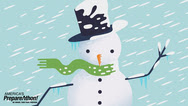The American Red Cross urges residents to take extra precautions with cooking and decorating this holiday season. Christmas Day, Christmas Eve and Thanksgiving are the top three days for cooking fires, according to the National Fire Prevention Association. Nationally, the Red Cross responds to a disaster on average every eight minutes, and the vast majority of these disasters are home fires.
“Cooking is the leading cause of home fires, and as people are cooking, entertaining, and stringing lights this holiday season, we’re urging that they take safety measures to ensure that their homes and loved ones are safe from the threat of fire,” said Maxine Margaritis, regional CEO, American Red Cross serving Orange, Riverside and San Bernardino Counties.
Additionally, Christmas trees account for hundreds of fires annually. One of every three home Christmas tree fires are caused by electrical problems and roughly one of every six Christmas tree fires is due to a heat source too close to the tree.
Home fires can be prevented. The Red Cross encourages everyone to take simple steps to keep their homes and loved ones safe from home fires this holiday season.
Holiday Entertaining
Test your smoke alarms.
Check food regularly while cooking and remain in the home while cooking. Use a timer as a reminder that the stove or oven is on.
Enforce a “kid-free zone” in the cooking area and make children stay at least three feet away from the stove.
Keep anything that can catch fire away from the stove, oven or any appliance in the kitchen that generates heat.
Clean cooking surfaces on a regular basis to prevent grease buildup.
Purchase a fire extinguisher to keep in the kitchen. Contact the local fire department to receive training on the proper use of extinguishers.
Holiday Decorating
Choose decorations that are flame resistant or flame retardant.
Keep children, pets and decorations away from lit candles.
Keep matches and lighters up high in a locked cabinet.
Replace any string of lights with worn or broken cords or loose bulb connections. Connect no more than three strands of mini light sets and a maximum of 50 bulbs for screw-in bulbs. Read manufacturer’s instructions for the number of LED strands to connect. Some strings of lights are only for indoor or outdoor use, but not both.
Use clips, not nails, to hang lights so the cords do not get damaged.
Keep decorations away from windows and doors.
Christmas Trees
Make sure the tree is at least three feet away from any heat source, like fireplaces, radiators, candles, heat vents or lights.
Make sure the tree is not blocking an exit.
Add water daily to the tree stand.
Always turn off tree lights before leaving home or going to bed.
After Christmas, remove the tree from your home when it begins dropping needles. Dried-out trees are a fire danger and should not be left in the home or garage, or placed outside against the home.
People should also download the free American Red Cross First Aid app, which provides instant access to information on handling the most common first aid emergencies. The apps can be downloaded from the Apple App Store and the Google Play Store for Android by searching for American Red Cross or by going to
redcross.org/mobileapps.
People can test their knowledge on how to prevent home fires by taking the
Fire Safety Quiz and can learn more about fire prevention by visiting
redcross.org.
About the American Red Cross:
The American Red Cross shelters, feeds and provides emotional support to victims of disasters; supplies about 40 percent of the nation's blood; teaches skills that save lives; provides international humanitarian aid; and supports military members and their families. The Red Cross is a not-for-profit organization that depends on volunteers and the generosity of the American public to perform its mission. For more information, please visit
redcross.org or visit us on Twitter at
@RedCross.






